

Table I: European Chemicals Agency July 2008 Candidate List of Substances of Very High Concern
Table source: http://echa.europa.eu/consultations/authorisation/svhc/svhc_cons_en.asp
Table source: http://echa.europa.eu/consultations/authorisation/svhc/svhc_cons_en.asp
In the past two decades there was a focus to restrict chemicals that posed special environmental risks, such as those that could deplete the ozone or harm wildlife (e.g. DDT). The trend now is to focus on chemicals that pose special human health risks.
Table I (below) provides an example of this trend. The chemicals listed are the first candidates for “substances of very high concern” (SVHC) under authority of the new EU REACH legislation. The majority of the chemicals on the current list are CMRs (carcinogen, mutagen or toxic to reproduction).
Some chemicals on the list already are being restricted.
About 30,000 chemicals are expected to be registered under REACH in the next several years. Since more than one-half of the budgets for chemical toxicity studies under REACH are for reproductive tests, CMRs (primarily “R”) should continue to outpace PBT (Persistent, Bioaccumulative and Toxic chemicals) and vPvB (very Persistent, very Bioaccumulative) as SVHC (just more acronyms to become familiar with).
Get management support
You will get management support when you effectively explain why certain chemicals should be restricted at the worksite. The need to restrict chemicals will vary depending upon industry sector. Management in the electronic sector, for example, probably is aware and may be eager to become RoHS-compliant (EU Restriction of Hazardous Substances Directive that took effect in July 2006). In this situation, management may appreciate why lead, mercury, cadmium, Cr+6, PBB and PBDE should be restricted for use at work. Focus “why” explanations based upon those chemicals that should be restricted within an industry sector.Establish policy & procedure
A policy may be viewed as a statement of destination. A procedure may be viewed as the roadmap to reach the destination. A policy and procedure should be written, dated and signed by the most senior manager responsible for the operation of the worksite. The procedure should include accountabilities and a schedule for periodic review. This is necessary to avoid any confusion on the topic and keep it up to date.If your company has no restricted chemicals policy, review those that have been developed for companies with ISO 14001 registrations within your industry and tailor them to meet local needs. It is unlikely that many of these policies at present specifically address new issues such as SVHC. Given the significance and global impact of SVHC, your policy should include a statement such as: “Our Company will restrict the purchase, use or disposal of all chemicals declared under EU REACH to be a substance of very high concern.” The policy should refer to a procedure that will carry out the details of the policy. The procedure should address contractors to ensure they do not use restricted chemicals during their activities at the worksite.
Plan for the “Râ€
The R (reproduction) part of CMRs may be especially troublesome in the U.S. For example, each of the phthalates along with lead hydrogen arsenate in Table I contain the risk phrase R61 “May cause harm to the unborn child.” U.S. limits such as PEL, REL and TLV generally do not address limits for the unborn child (i.e. pregnant worker). For example, the PEL and TLV for dibutyl phthalate do not account for effects upon the unborn child and their limits are both at 5 mg/m3. When effects upon the unborn child are considered, an Occupational Reproductive Guideline at 0.72 mg/m3 is suggested.1Address “low doseâ€
As scientific capabilities expand, finding chemicals in very low amounts becomes more practical. Finding a chemical at one part per billion is equivalent to a measurement of one second in 32 years. An acceptable threshold should be stated for a restricted chemical even if you couch it with the phrase “at the limit of analytical detection by approved scientific methods.” Avoid the use of “no” when referring to a chemical amount.Expert help
Given the complexity of this issue, you may need to seek expert help in building an effective procedure. To name just a few, specialists such as www.chemadvisor.com, consultants with expertise in the topic such as www.bureauveritas.com, or software companies (with restricted chemical lists) such ashttp://www.micromedex.com/products/ehs/may be very helpful.Reference
1. Reproductive Hazards of the Workplace, Frazier et al, John Wiley & Sons, Inc., 1998



